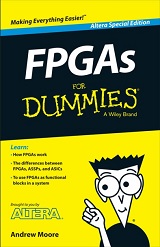
|
FreeComputerBooks.com
Links to Free Computer, Mathematics, Technical Books all over the World
|
|
- Title FPGAs for Dummies (Intel® and Altera Special Edition)
- Author(s) Andrew Moore
- Publisher: Intel® and Altera
- Hardcover/Paperback N/A
- eBook PDF
- Language: English
- ISBN-10: N/A
- ISBN-13: 978-1118944
- Share This:

|
Field Programmable Gate Arrays (FPGAs) are integrated circuits that enable designers to program customized digital logic in the field. The FPGA has evolved from a useful but humble interface device into a system-level integrated circuit (IC) with its own microprocessors, memory blocks, and interfaces.
If you are completely new to FPGAs, or if you want a refreshing high level view of what FPGAs are and what are the future trends in the field, it will help you understand the practical uses of FPGAs.
This eBook examines how FPGAs work, the history, and the future of FPGAs in system design including heterogeneous computing and OpenCL.
- The pros and cons of using FPGAs
- The modern design flow of FPGAs
- Ways to use FPGAs as functional blocks in your system
- Make an informed choice about using FPGAs in your designs by harnessing their power and flexibility!
- N/A
- Field Programmable Gate Arrays (FPGA)
- Hardware Description Language (HDL), VHDL, Verilog, etc.
- Electronics Circuit Design and Programming
- Electronic Engineering
- Embedded Systems Books

- FPGAs for Dummies (Andrew Moore) - Altera® Special Edition
- The Mirror Site (1) - PDF
- Learning FPGAs: Digital Design for Beginners with Mojo and Lucid HDL (Justin Rajewski)
-
 FPGAs!? Now What? - Learning FPGA Design with the XuLA Board
FPGAs!? Now What? - Learning FPGA Design with the XuLA Board
This book will briefly describe FPGAs and then show you how to apply them to your problems using a low-cost board and some free software. It discusses how to use the Xilinx ISE WebPACK software to build FPGA designs for the XuLA FPGA board.
-
 Parallel Programming for FPGAs (Ryan Kastner, et al.)
Parallel Programming for FPGAs (Ryan Kastner, et al.)
Aimed at teaching hardware and software developers how to efficiently program FPGAs using high-level synthesis (HLS). Focuses on the use of algorithmic high-level synthesis (HLS) to build application-specific FPGA systems.
-
 The Emergence of FPGA-Based Prototyping for SoC Design
The Emergence of FPGA-Based Prototyping for SoC Design
Making FPGA prototyping part of the design process early means actually thinking about how the design will be prototyped via an FPGA. It tells the history of FPGA-based prototyping and three leading system providers – S2C, Cadence, and Synopsys.
-
 Introducing the Spartan-3E FPGA and VHDL (Mike Field)
Introducing the Spartan-3E FPGA and VHDL (Mike Field)
This is an introduction to FPGAs and VHDL. It discusses the low level details of working with FPGAs, rather than diving straight into the System on a Chip (SOAC) level. The book examples are mainly oriented to Xilinx Spartan 3E FPGA.
-
 High-Speed Serial I/O: A Designer's Guide with FPGA Apps
High-Speed Serial I/O: A Designer's Guide with FPGA Apps
This book introduces the basic concepts for anyone who wishes to learn or refresh his/her concepts about high-speed serial links. Understand the Field Programmable Gate Arrays (FPGA) architecture and its implementation.
-
 Exploring Zynq MPSoC: With PYNQ and Machine Learning Apps
Exploring Zynq MPSoC: With PYNQ and Machine Learning Apps
Introduces the Zynq MPSoC (Multi-Processor System-on-Chip), an embedded device which combines a sophisticated processing system that includes ARM Cortex-A53 applications and ARM Cortex-R5 real-time processors, with FPGA programmable logic.
-
 Free Range VHDL: The No-frills Guide to Writing Powerful Code
Free Range VHDL: The No-frills Guide to Writing Powerful Code
The purpose of this book is to provide students and young engineers with a guide to help them develop the skills necessary to be able to use VHDL for introductory and intermediate level digital design.
-
 The VHDL Golden Reference Guide (DOULOS)
The VHDL Golden Reference Guide (DOULOS)
Packed with practical advice distilled from years of experience teaching VHDL courses, this book is designed for the experienced design engineer, offers answers to the questions most often asked during practical application, in a convenient reference format.
-
 VHDL Handbook (Hardi Electronics)
VHDL Handbook (Hardi Electronics)
This book has become a standard reference in the industry for learning the features of VHDL and using it to verify hardware designs, with many complete examples used to illustrate the features of the VHDL language.
-
 The VHDL Cookbook, First Edition (Peter J. Ashenden)
The VHDL Cookbook, First Edition (Peter J. Ashenden)
The book begins with the basics of VHDL, which, like any software language, has keywords, operators, flow control statements, and programming conventions, then moves on to more complicated models, such as a design for a complete CPU.
-
 Digital Design with RTL Design, VHDL, and Verilog (Frank Vahid)
Digital Design with RTL Design, VHDL, and Verilog (Frank Vahid)
Offering a modern, updated approach to digital design, this much-needed book reviews basic design fundamentals before diving into specific details of design optimization. Starts with the low-levels of design, then progresses to the key uses of digital design today.






